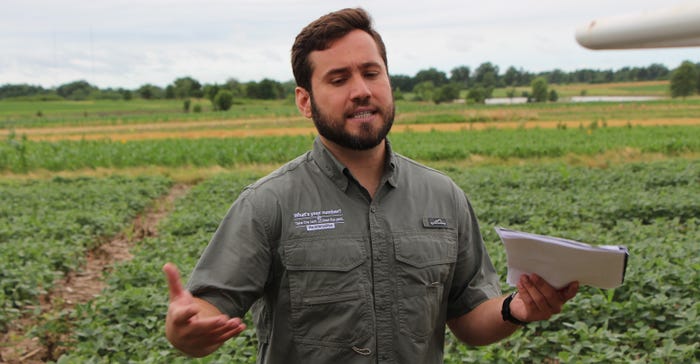
When it comes to managing soybean cyst nematodes, Mandy Bish likens it to walking back in time to the late 1990s and early 2000s when farmers were spraying the herbicide Roundup to control weeds — and the weeds started showing resistance.
“It almost seems like we’re getting to that tipping point with SCN as far as what we have to control it,” warns the University of Missouri Extension specialist in plant science and technology.
Bish is not the only one concerned. According to the SCN Coalition, planting an SCN-resistant variety is a soybean grower’s first line of defense, but Iowa State University nematologist Greg Tylka says that in many fields, SCN has become “resistant to the resistance because the same source of SCN resistance, known as PI 88788, has been used in about 95% of SCN-resistant soybean varieties for decades.”
In a SCN Coalition report, Tylka shares how data from 15 years of variety trial experiments in growers’ fields in Iowa revealed that increased reproduction of SCN populations on PI 88788-resistant varieties can decrease yield by as much as 14 bushels per acre, which represents a 23% yield loss. At cash prices of $15 per bushel, that is $210 per acre.
“When you consider that these studies were conducted in farmer fields with the traditional corn-soybean rotation, I shudder to think about the potential yield loss a farmer faces planting soybeans consecutive years in SCN-infested fields,” Tylka adds.
Shift resistant varieties
Many farmers turn to resistant soybean varieties as a management tool for SCN. Jeff Barizon, MU senior research specialist, says this helps farmers in two ways. First, they can protect yield, and second, they leave behind lower SCN numbers in the field.
But as Tylka found, the problem with resistant varieties is that the majority available to growers come from the same source of PI 88788 resistance.
“We have seen SCN populations in Missouri be able to reproduce at a high level with that resistant source,” Barizon explains during the MU Pest Management Field Day. “We are losing effectiveness of those good resistant varieties.”
All PI 8878 resistance is not equal. Bish points out that the level of SCN resistance can vary by variety, meaning there are more copies at the molecular level in some varieties than others. She notes that farmers who grew a PI 88788-resistant soybean variety in their last rotation should plant a variety with SCN resistance from Peking the following year, if possible.
Varieties with Peking resistance are available up to maturity group 3, which may be suitable for northern Missouri. However, most soybeans planted in Missouri are from later maturity groups. Farmers can also rotate among varieties with PI 88788 resistance.
Reduce nematode numbers
Another option to reduce SCN numbers is rotation with a nonhost crop, with the most popular being planting corn after soybeans.
In one season, researchers found this rotation can reduce nematode numbers significantly. However, Barizon notes that switching to corn does not eliminate the problem.
“Mother Nature always adapts,” he explains. “So the second year you plant corn, you’re still going to see a reduction in SCN numbers, but that reduction is going to be much less.”

Jeff Barizon, MU senior research specialist, shares the latest university research about soybean cyst nematodes during the MU Pest Management Field Day. He notes that SCN is showing resistance to PI 88788-resistant soybean varieties.
While nematode-protectant seed treatments are now in the SCN space, so far, they produce varying results.
MU is part of a multistate research project testing seed treatments in both the greenhouse and field. The results were more consistent in the greenhouse trials. Barizon says environmental factors may influence effectiveness, and “no seed treatment consistently reduced SCN reproduction in the field.”
Formidable foe
SCN is the most damaging soybean pathogen in North America, with yield losses twice that of any other soybean disease over the past 10 years.
If soybean cyst nematode pressure is high enough in any field, crop rotation, resistant soybean varieties or nematode-protectant seed treatments are not going to protect against yield loss.
“I'm afraid we're not getting that message to farmers,” Bish says. “If you have nematodes present at high enough densities in a field, that's a sign that your management practices are not working, and you are likely losing yield.”
She adds that farmers should focus on using tools to keep nematode populations low year in and year out.
The Missouri Soybean Merchandising Council, along with the United Soybean Board, will pay for samples from Missouri farm fields, a couple of samples per farmer, Bish says.
She adds that farmers must take many samples to gauge SCN levels. Just because nematodes don’t show up in one area doesn’t mean they aren’t out in force in another. Actually, SCN only moves inches in its lifetime. What increases the spread of nematode populations is soil movement via tillage or water.
The MU breeding program continues to work with MSMC to develop new SCN-resistant soybean varieties. Until then, farmers must remain diligent in reducing nematodes on the farm with the tools available.
On the rise
SCN is widely distributed in soybean growing regions of the U.S. and contributes to $1.5 billion in losses for farmers annually. A 2018 Missouri survey found that 88% of soybean fields in the state had detectable levels of SCN. That is a dramatic increase from a survey more than 10 years prior, where 50% fields reported nematodes. That is a 38% increase or spread of SCN in the state.
About the Author(s)
You May Also Like






